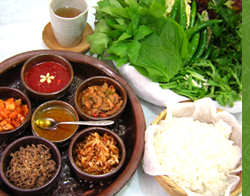1. Birth and Samchil day
The 21st day after a baby's birth is called samchil day. This is probably because the number seven (chil in Korean) was considered lucky. On this day, family and friends visit to celebrate the birth of a newborn and comfort the mother after giving labor. Seaweed soup with beef broth is served to the mother.
 |
2. Baekil
Baekil is an occasion marking the 100th day after a baby is born. One hundred is a number symbolic of completeness and maturity; therefore, baekil is an occasion for congratulating a baby on completing this phase and wishing him or her continued growth and good health for the future.
At a baekil celebration, a table is set with a bowl of plain rice, seaweed soup with beef broth and green vegetables. Steamed white rice cake, glutinous millet dumplings rolled in red bean powder and songpyeon (half-moon shaped rice cake) in five different colors are also prepared. On this day, congratulatory foods were shared with others. In particular, it was believed that rice cakes prepared for baekil should be shared with one hundred families in order for the baby to be blessed with good health and longevity. The families who offered rice cakes would in turn give a bundle of white cotton thread or rice instead of returning the dish empty. White cotton thread and rice signify longevity and wealth.
3. Baby's First Birthday
 |
On a baby's first birthday, people pray for his or her longevity, fortune, and success. A new outfit is made for the baby and a table is set mainly with various rice cakes and fruit for doljabi. On a first birthday, plain rice is served in a rice bowl and seaweed soup in a soup bowl, both newly prepared for the baby. Green vegetables and fruit are also served. Steamed white rice cake and millet dumplings are an essential part of the celebration. The fruit is selected to create a colorful arrangement. Various foods and a variety of items are placed on a table to allow the baby to reach for the item of his or her preference in a unique ceremony called doljabi. The baby's destiny may be told based on the item that is picked up by the baby. For a baby boy, rice, a bundle of white thread, a book, paper, and bow and arrow are placed on the table. For a baby girl, a pair of scissors, needles and a ruler are laid out instead of a bow and arrow.
4. Wedding ceremony
 |
The wedding ceremony is one the most important events in one's life, marking the uniting of a man and a woman as husband and wife. According to tradition, before the wedding the bridegroom's family sends a box containing chaedan (wedding presents sent by the bridegroom's family for the bride's family) and a written marriage oath to the family of his bride. This box is called ham. Once the ham arrives at the bride's house, it is placed atop a rice-cake steamer in which bongchaetteok (steamed glutinous rice cake sprinkled with red bean powder) are prepared. At the center of the top layer, seven jujubes are placed in a radiant shape. Bongchaetteok is prepared to wish the couple a relationship that is as fast and tenacious as the glutinous rice that is made from. The rice cake is shaped in two layers to symbolize a couple. The red beans are to ward off misfortune whereas the seven jujubes represent seven sons to wish the couple many sons and prosperity.
A wedding ceremony is performed at the bride's house involving a ritual performed by the bride and bridegroom. Guests at the reception are served noodles. On the following day, the bride and bridegroom go the bridegroom's house and the bride formally greets his parents and other senior members of the family for the first time. This is called pyebaek. Although there are slight variations across regions, jujubes, chestnuts, beef jerky, and alcoholic beverages are usually served. Although the traditional wedding ceremony is not performed today, pyebaek is still practiced.
5. The sixtieth birthday
 |
The sixtieth birthday is referred to as hoegap, and the children normally hold a banquet for their parents to celebrate the occasion. "Hoegap," or anniversary, means a return to the year one was born. The occasion is also called hwangap or hwagap, as the parts of the character hwa (華) that add up to 61. (In Korea, age is counted as portions of years lived and not full years elapsed since birth, so 60 is counted as 61.)
A sumptuous table of food is prepared for the sixtieth birthday banquet. Because high piles of foods are placed on the table, it is called gobaesang (a table of high piles) or mangsang (a table to gaze at). A sumptuous table is also set for a wedding ceremony or a seventieth birthday. This is the most extravagant of Korean table-settings. Fresh fruit, pan-fried fish, dried beef or fish, rice cakes, traditional Korean baked goods and many other foods are piled in 30-60 centimeter-tall round stacks, which are then placed in 2-3 colorful rows.
6. Memorial services
 |
Memorial services are rituals held by descendants in memory of the deceased. Koreans hold rituals on the anniversary of an ancestor's death, New Year's Day, and Chuseok (Korean Thanksgiving) to express gratitude for their blessings and to pay their respects. The foods prepared for these rituals are not extravagant. On New Year's Day, tteokguk (rice cake soup) is prepared, and on Chuseok, taro soup and songpyeon are served. The assortment of dishes and their arrangements vary from family to family and according to region. Common offerings include alcoholic beverages, fruit (both fresh and dried), dried beef, and fish. Again, rice cakes are a standard food which are prepared with mung bean powder or husked red bean powder sprinkled on top.
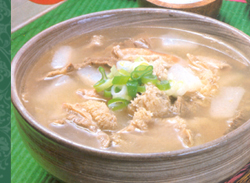
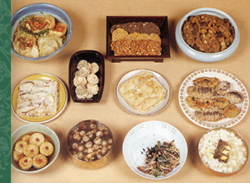

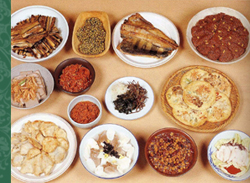
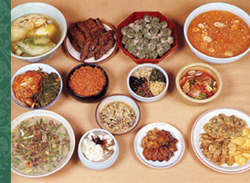

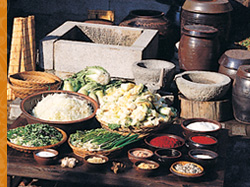
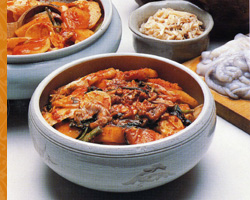
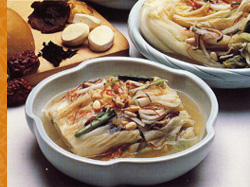
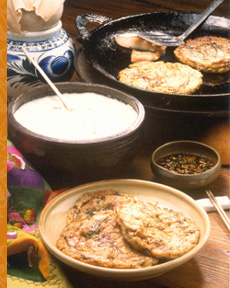
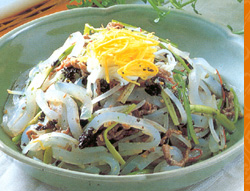 Tangpyeongchae, enjoyed in late spring, is a mix of green bean jelly, pork, dropwort and dried laver seasoned with soy sauce and vinegar. Tangpyeong
means maintaining one's balance. King Yeongjo allegedly created
Tangpyeongchae out of a strong desire for balance among parties.
Tangpyeongchae, enjoyed in late spring, is a mix of green bean jelly, pork, dropwort and dried laver seasoned with soy sauce and vinegar. Tangpyeong
means maintaining one's balance. King Yeongjo allegedly created
Tangpyeongchae out of a strong desire for balance among parties.
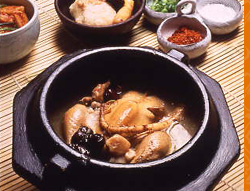 Gijutteok is a rice cake enjoyed in summer. It is prepared by mixing rice flour with liquor and then steaming the fermented dough.
Gijutteok is a rice cake enjoyed in summer. It is prepared by mixing rice flour with liquor and then steaming the fermented dough.
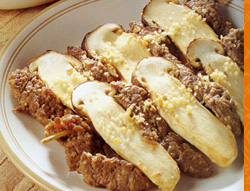 In fall, the harvest is at its peak and the new crop of the year is rich, as are the hearts of the people. Chuseok is also called Gabae or Hangawi. In rural areas, lunar New Year's Day and Chuseok
are considered as the most important holidays. As it is the season when
five different grains are fully grown, fruits are ripe and vegetables
are abundant, new grain liquors are brewed from the fresh crops. Fresh
fruits are picked and offerings for ancestors are prepared to be used in
a rite. This is called the Chuseok rite. Festive foods for Hangawi include songpyeon (stuffed rice cake), torantang (taro soup), various seasoned vegetables and galbijjim (rib stew).
In fall, the harvest is at its peak and the new crop of the year is rich, as are the hearts of the people. Chuseok is also called Gabae or Hangawi. In rural areas, lunar New Year's Day and Chuseok
are considered as the most important holidays. As it is the season when
five different grains are fully grown, fruits are ripe and vegetables
are abundant, new grain liquors are brewed from the fresh crops. Fresh
fruits are picked and offerings for ancestors are prepared to be used in
a rite. This is called the Chuseok rite. Festive foods for Hangawi include songpyeon (stuffed rice cake), torantang (taro soup), various seasoned vegetables and galbijjim (rib stew).
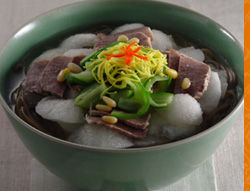 Dongji
(the winter solstice) is the longest night and shortest day of the
year. Meaning "a day that ushers in the following year," Dongji was also
called ase (sub-year) or "little New Year's Day."
Dongji
(the winter solstice) is the longest night and shortest day of the
year. Meaning "a day that ushers in the following year," Dongji was also
called ase (sub-year) or "little New Year's Day."










